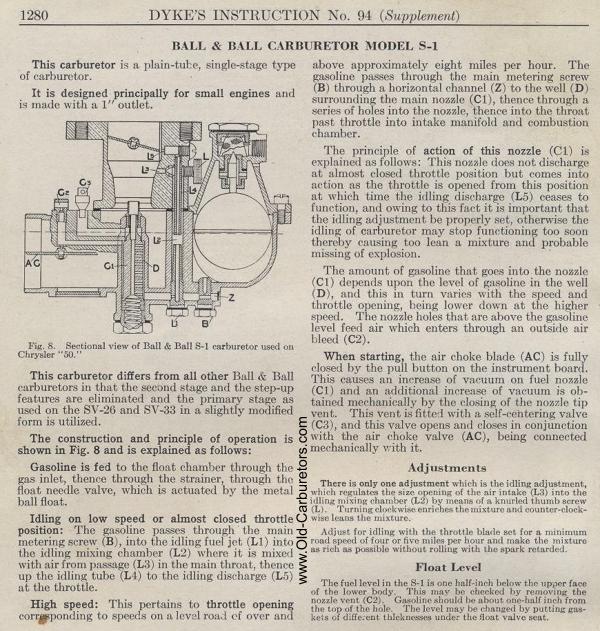BALL & BALL CARBURETOR MODEL S-1
This carburetor is a plain-tube, single-stage type of carburetor.
It is designed principally for small engines and is made with a
1" outlet.
Fig. 8. Sectional view of Ball & Ball S-1 carburetor
used on Chrysler "50"
This carburetor differs from all other Ball & Ball
carburetors in that the second stage and the step-up features are eliminated
and the primary stage as used on the SV-26 and SV-33 in a slightly
modified form is utilized.
The construction and principle of operation is shown in Fig. 8
and is explained as follows:
Gasoline is fed to the float chamber through the gas inlet, thence
through the strainer, through the float needle valve, which is
actuated by the metal ball float.
Idling on low speed or almost closed throttle position: The gasoline
passes through the main metering screw (B), into the idling fuel
jet (Ll) into the idling mixing chamber (L2) where it is mixed
with air from passage (L3) in the main throat, thence up the idling
tube (LI) to the idling discharge (L5) at the throttle.
High speed: This pertains to throttle opening corresponding to
speeds on a level road of over andabove approximately eight miles
per hour. The gasoline passes through the main metering screw (B)
through a horizontal channel (Z) to the well (D) surrounding the
main nozzle (Cl), thence through a series of holes into the nozzle,
thence into the throat past throttle into intake manifold and combustion
chamber.
The principle of action of this nozzle (Cl) is explained as follows:
This nozzle does not discharge at almost closed throttle position
but comes into action as the throttle is opened from this position
at which time the idling discharge (L5) ceases to function, and
owing to this fact it is important that the idling adjustment be
properly set, otherwise the idling of carburetor may stop functioning
too soon thereby causing too lean a mixture and probable missing
of explosion.
The amount of gasoline that goes into the nozzle (Cl) depends upon
the level of gasoline in the well (D), and this in turn varies
with the speed and throttle opening, being lower down at the higher
speed. The nozzle holes that are above the gasoline level feed
air which enters through an outside air Bleed (C2).
When starting, the air choke blade (AC) is fully closed by the
pull button on the instrument board. This causes an increase of
vacuum on fuel nozzle (Cl) and an additional increase of vacuum
is obtained mechanically by the closing of the nozzle tip vent.
This vent is fitted with a self-centering valve (C3), and this
valve opens and closes in conjunction with the air choke valve
(AC), being connected mechanically with it.
Adjustments
There is only one adjustment which is the idling adjustment, which
regulates the size opening of the air intake (L3) into the idling
mixing chamber (L2) by means of a knurled thumb screw (L). Turning
clockwise enriches the mixture and counter-clockwise leans the
mixture.
Adjust for idling with the throttle blade set for a minimum road
speed of four or five miles per hour and make the mixture as rich
as possible without rolling with the spark retarded.
Float Level
The fuel level in the S-1 is one half-inch below the upper face
of the lower body. This may be checked by removing the nozzle vent
(C2). Gasoline should lie about one-half inch from the top of the
hole. The level may he changed by putting gaskets of different
thicknesses under the float valve seat.
Previous page 1927
Supplement Home Next page 
|
